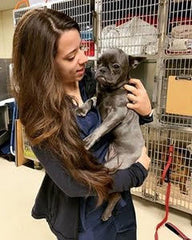By: Nicole LaForest-Mayo BSc., LVT, RVT, CCFT
Becoming a veterinary technician was one of the hardest things I have ever done, and many who have gone through the process would agree. For me, I entered college to become a veterinary technician at a pivotal time in our industry. I attended a distance-learning, at your own pace, program which was viewed as taboo and highly controversial at the time that I graduated. Can you learn the necessary skills to become a successful patient advocate? Could you have success in your career by attending college online? Yes, absolutely.
I fought tooth and nail to be where I am today, and through my dedication to the profession; I’ll continue to promote patient care through my desire and willingness to bring my patients the best care available.
There are very few states who currently honor uncredentialed individuals with the title of veterinary technician, and no; I will not delve into my stance beyond the fact that I advocate for knowledgeable, ethical and legally entitled professionals on all levels of animal care.
In a majority of states and US territories, to become a veterinary technician you must graduate from an AVMA accredited program where you hone your skills working on large, small and exotic animals. After graduating with an associate's or bachelor’s degree in veterinary science, technician, technology and now even (veterinary) nursing, you will then have to take and pass your Veterinary Technician National Exam (VTNE) which is offered through the American Association of Veterinary State Boards (AAVSB). The VTNE contains 170 questions, with 20 of those questions being pilot questions, to pave way for future VTNE test-takers. The pilot questions are unscored and unmarked. Scary? You bet.
Now, what does the VTNE consist of? Anesthesia, Emergency and Critical Care, Pain Management and Analgesia, Pharmacology, Dentistry, Laboratory Procedures, Diagnostic Imaging, Animal Care and Nursing as well as Surgical Nursing. Divide those domains across various species, and don’t forget that virtually any detail of your schooling may be applicable to the exam.
The VTNE is reported on a scaled score from 200 to 800, with the magic passing number being 425. According to the AAVSB; the three-year national pass rate for the VTNE is 70.31% as reported by the board in April of 2018. Why is this pass rate not as bad as it sounds? This exam is brutal and in no way does a written test measure your abilities and capabilities of what you can do as a credentialed veterinary technician. Whether you agree with that statement or not, just remember that standardization is the key to elevating our standard of care.
After passing the VTNE, and depending on your state or territory in the United States, a jurisprudence tests; also known as a state exam, must be completed in accordance with their regulations. A background check may also be required along with biometrics to act as a deterrent for individuals with a history of violence or unauthorized drug use. There are states where a jurisprudence exam is not applicable and passing the VTNE will allow you to immediately begin working in the veterinary industry.
Currently, there are very few states that offer reciprocity for credentialed veterinary technicians to seamlessly work in various parts of our country without having to obtain a permanent or temporary state licenses. This concept of unity and standardization across our country will ultimately be the key to elevating the veterinary technology profession.
Now that you’ve finally busted into veterinary medicine as a credentialed veterinary technician, the fun is just beginning:
Looking into the future of the animal health industry, it’s important to focus on our unified voice as the advocates for our patients and clients. Regardless of whether you are a veterinary assistant, technician, receptionist, veterinarian or even a volunteer; it’s crucial that we set our eyes, conclusively, on what is best for our patients.
-----

About the author:
Nicole is a LVT in WA State and carries dual credentialing in CA as a RVT and is the current President of the Washington State Association of Veterinary Technicians.
Nicole carries a bachelor degree in psychology and human healthcare management along with her associates degree in veterinary technology and music.
She is a part of the VTS Regenerative Medicine Initiative and can be frequently found lecturing at many national and international conference on this subject and more.
Nicole is a blog writer for I Love Veterinary Medicine and writes case studies to almost 16,000 professionals under @veterinarytechnicians on Instagram!
